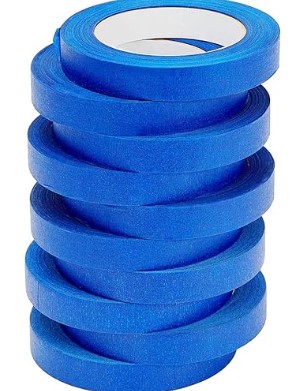Precision and control are paramount when painting surfaces during home renovation projects. An ideally cut ceiling or wall line ensures a seamless and professional finish. However, achieving such accuracy freehand can be challenging. Over many years in the painting trade, we have discovered that masking tape is one of the most effective yet underutilized tools for creating sharp paint edges.
Through meticulous taping techniques and precise removal, homeowners and DIY enthusiasts can transform their walls from an amateur job to a polished presentation. This article will explore various taping strategies and recommendations to help any painter confidently tackle wall preparation, paint application, and surface protection with tape for a showroom-quality result.
Precision Perfection: How Masking Tape Creates Clean Lines in Painting Projects
Precision and perfection are critical elements in any painting project, especially in industrial environments where the ceiling may be too high for traditional methods. It is where masking tape comes into play. With its unique adhesive properties, masking tape creates clean lines that are crisp and straight. Industrial ceiling spraying, for example, demands a high level of accuracy and efficiency.
Without masking tape, the results would be far from satisfactory, with paint bleeding outside designated areas. By utilizing this tool, painters can create perfect lines that will impress. Its ease of use and accessibility make it a must-have for any painting job, big or small.
A Creative Canvas: Using Tape to Add Unique Accents and Design Elements to Walls
Aside from its accuracy and precision, masking tape can also be used as a creative tool to add unique accents or design elements to walls. Homeowners can create interesting patterns or shapes on their walls by strategically placing and layering tapes of different widths and colors. This technique is especially popular in modern interior design, where geometric shapes and bold colors are often incorporated into room designs.
Furthermore, using tape as a stencil for painting can give walls a unique and personalized touch. This method is perfect for creating custom murals, textured effects, or wall lettering. The possibilities are endless with masking tape as a creative partner in home renovation projects.
Beyond the Basics: Advanced Taping Techniques for Dividing Spaces and Drawing Attention
While masking tape is commonly used for creating clean lines and designs, it can divide spaces and draw attention to specific areas. It is beneficial in open-concept living spaces where defining different zones can be challenging. For example, by using a bold color or patterned tape, homeowners can create a clear separation between a dining area and a living room. This technique adds a unique touch to the space and helps with organization and functionality.
Moreover, using tape to highlight architectural features or draw attention to specific areas of a room can enhance the overall design. By placing tape along corners, edges, or around accent walls, homeowners can add depth and character to their rooms.
Measuring Up: Tips for Proper Measurement and Tape Application to Ensure a Polished Look
Before beginning any taping project, it is essential to measure and plan out the placement of the tape properly. Improper measurement can result in uneven lines or gaps between tape strips, ultimately affecting the overall look of the finished product. It is recommended to use a measuring tool such as a ruler or measuring tape and mark the desired lines lightly with a pencil before applying the tape.
When applying the tape, it is crucial to ensure that it is pressed firmly onto the surface and there are no air bubbles underneath. It will prevent paint from seeping under the edges of the tape and creating unwanted streaks or lines. Removing the tape at a 45-degree angle can also help achieve cleaner lines and minimize any potential damage to the surface.
Painting Perimeters: Maximizing Your Materials with Tape on Windows, Doors and Baseboards
Taping is not just limited to walls and ceilings; it can also protect surfaces such as windows, doors, and baseboards during the painting process. By carefully taping around these areas, homeowners can avoid accidental splatters or spills while painting. It saves time on cleanup and ensures a clean and professional finish.
Another helpful tip is to use wider tape for larger surfaces and narrower tape for smaller or more intricate areas. It will help achieve better coverage while minimizing potential damage to delicate surfaces.
Detailed Delineation
In addition to protecting surfaces, tape can also be used to highlight molding and create sharp transitions between different paint colors. Homeowners can achieve a crisp and defined look by carefully taping along the edges of molding before painting. This technique is beneficial for intricate or detailed moldings that may be difficult to paint freehand.
Furthermore, using tape can help achieve clean color transitions on walls with multiple hues. By taping along the edges where two colors meet, homeowners can ensure a seamless blend between the colors without bleeding or smudging.
A Temporary Touch
One of the most satisfying moments in a painting project is removing the tape to reveal perfectly painted edges. This step showcases the precision and attention to detail put into the project. To avoid damage, remove the tape carefully and steadily. Use a sharp utility knife or razor blade to cut and prevent potential damage. After removal, check for touch-ups and fix them before showcasing your flawless paint job.










